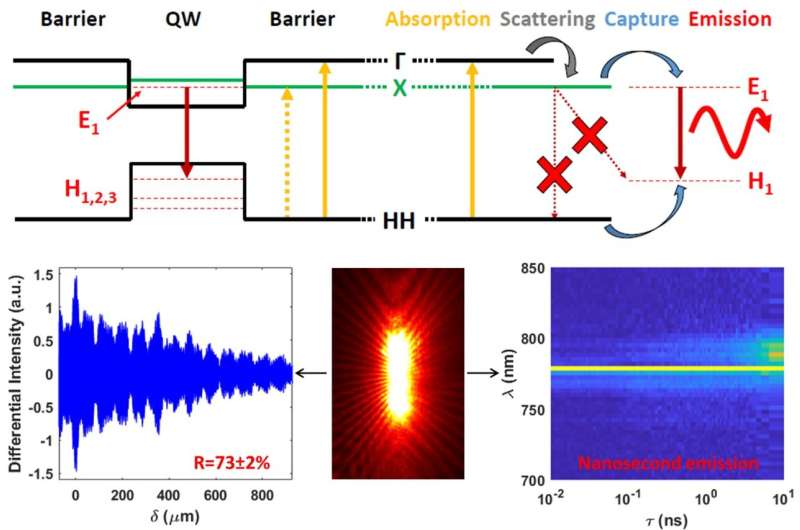Heterostructure and Q-factor engineering for low-threshold and persistent nanowire lasing

Semiconductor nanowire lasers are a crucial component for on-chip integrated optoelectronics. However, silicon-integrated, room-temperature, continuously-operating and electrically-pumped nanowire lasers have not yet been demonstrated. In this work, a method to achieve low-threshold quasi-four-level lasing using indirect-to-direct band scattering is shown. This is enabled by the use of a high-Q cavity, and—using a time-gated interferometry technique—the end-facet reflectivity is directly measured for the first time.
Over the past decade, the idea of photonic computing—where electrons are replaced with light in microelectronic circuits—has emerged as a future technology. This promises low-cost, ultra-high-speed and potentially quantum-enhanced computing, with specific applications in high-efficiency machine learning and neuromorphic computing. While the computing elements and detectors have been developed, the need for nanoscale, high-density and easily-integrated light sources remains unmet. Semiconductor nanowires are seen as a potential candidate, due to their small size (on the order of the wavelength of light), the possibility for direct growth onto industry-standard silicon, and their use of established materials. However, to date, such nanowire lasers on silicon have not been demonstrated to operate continuously at room temperature.
In a new paper published in Light Science & Applications, scientists from the Photon Science Institute in Manchester, UK with colleagues at University College London and the University of Warwick demonstrate a new route to achieving low-threshold silicon-integratable nanowire lasers. Based on novel direct-indirect semiconductor heterostructures enabled by the nanowire platform, they demonstrate multi-nanosecond lasing at room temperature. A key design element is the need for high-reflectivity nanowire ends; this is typically a challenging requirement, as common growth methods do not allow simple optimization for high quality end-facets. However, in this study, by employing a novel time-gated interferometer the researchers demonstrate that the reflectivity can be over 70%—around double that expected for a conventional flat-ended laser due to the confinement of light.
Together, the novel material structure and high quality cavity contribute to a low lasing threshold—a measure of the power required to activate lasing in the nanowires—of just 6uJ/cm2, orders of magnitude lower than previously demonstrated. Not only does this new approach provide high quality nanolasers, but the MBE growth provides a high-yield of functioning wires, with over 85% of nanowires tested working at full power without thermal damage. This high yield is critical for industrial integration of this new structure.
More information: Stefan Skalsky et al, Heterostructure and Q-factor engineering for low-threshold and persistent nanowire lasing, Light: Science & Applications (2020). DOI: 10.1038/s41377-020-0279-y
Journal information: Light: Science & Applications
Provided by Chinese Academy of Sciences





















